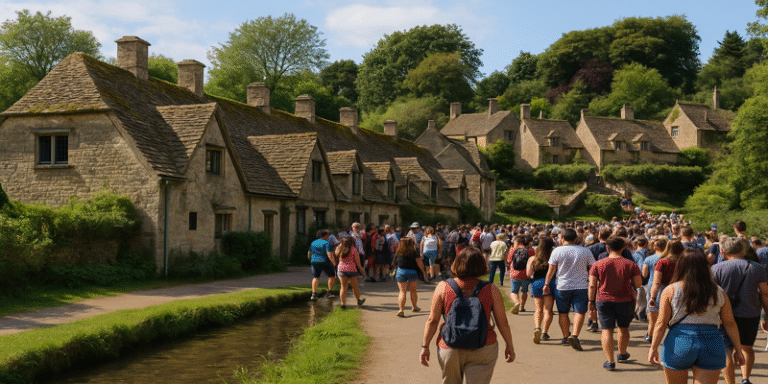When the artist and designer William Morris described Bibury as “the most beautiful village in England”, he was echoing a sentiment that has only deepened over time (White, 2010). Nestled in the heart of the Cotswolds, this small village in Gloucestershire captures the romantic image of quintessential rural England. Its honey-coloured cottages, tranquil riverbanks, and historic charm have made it a favourite among visitors from across the world. Today, Bibury continues to stand as both a living community and a tourism landmark, showcasing the delicate balance between preserving heritage and welcoming modern travellers.
A Village Steeped in History
Bibury’s history stretches back over a thousand years, with its roots visible in both its built heritage and landscape setting. The Domesday Book of 1086 records Bibury as part of the estates of St. Mary’s Priory, Worcester (Dyer, 2007). The village prospered in the medieval wool trade, with the local Cotswold sheep providing high-quality wool that was sought across Europe. The enduring presence of the River Coln provided the necessary water resources for milling and fulling, helping to establish Bibury as a thriving economic hub during the Middle Ages (Thirsk, 2002).
The most iconic part of the village is undoubtedly Arlington Row, a line of 17th-century weavers’ cottages built on the foundations of a 14th-century wool store. Today, this row is one of the most photographed sites in England and is protected by the National Trust (Macdonald, 1929). Bibury’s famous Arlington Row cottages date to the 17th century and remain one of England’s most photographed scenes, drawing huge crowds—sometimes up to 10,000 visitors a day—creating friction between tourism and residents (Wikipedia, 2025a; The Sun, 2025; The Sun, 2025). Its preservation reflects the wider Cotswolds’ emphasis on heritage conservation, where architecture, landscape, and community are closely interlinked.
The Cultural Significance of Bibury
Bibury is more than just a pretty village; it plays a central role in English identity and cultural heritage. Scholars argue that the Cotswolds, and Bibury in particular, serve as visual metaphors for a nostalgic, pastoral England (Brace, 1997). The stone cottages, built with the distinctive Cotswold limestone, embody a form of vernacular architecture that speaks to both functionality and beauty (Oliver, 2007).
Tourism researchers note that places like Bibury function as “honeypot” destinations—sites of concentrated visitor interest due to their iconic status (Turner, 2020). The presence of international visitors, including Japanese tourists drawn by Emperor Hirohito’s reputed stay in the 1920s, has only reinforced Bibury’s image as a global representation of rural England (Hashimoto and Telfer, 2023).
Tourism in Bibury
Tourism is the lifeblood of modern Bibury. The village’s compact size belies its importance as one of the most visited spots in the Cotswolds. Visitors flock to stroll along Arlington Row, explore the village church of St. Mary’s, or enjoy the riverside Rack Isle Nature Reserve, managed by the National Trust for its wildlife and traditional water meadows (Lonely Planet, 2019).
The Bibury Trout Farm, founded in 1902, is another key attraction, offering both an insight into aquaculture and the opportunity for visitors to catch their own fish. This blend of heritage tourism, nature-based tourism, and experiential attractions makes Bibury a particularly versatile destination.
However, the influx of visitors also presents challenges. Griffiths (2017) highlights that tourism in villages like Bibury can sometimes reduce local communities to “stage sets”, where the demands of visitors overshadow the needs of residents. As such, managing the balance between authentic village life and visitor experiences remains an ongoing challenge.
Architectural and Landscape Heritage
The defining feature of Bibury is its built heritage, with cottages that have remained virtually unchanged for centuries. The vernacular architecture, constructed from local limestone with steep gabled roofs, reflects the Arts and Crafts tradition that emerged in the wider Cotswolds (Gordon, 1996). Scholars note that Bibury’s cottages not only provide housing but also act as symbols of continuity, linking present-day residents with their ancestors (Oliver, 2007).
Equally important is the surrounding landscape. The Cotswolds Area of Outstanding Natural Beauty (AONB) encompasses Bibury, and the River Coln provides both ecological and aesthetic value. Studies emphasise that landscape and settlement are inseparable in the Cotswolds, with the stone buildings harmonising with rolling hills and river valleys (Powell and Clark, 2003). This careful integration is what makes Bibury so visually striking.
Bibury in Literature, Film, and Media
Bibury’s beauty has long been celebrated in literature, art, and more recently, film. Beyond William Morris’s endorsement, Bibury has appeared in numerous guidebooks and travelogues since the 19th century (Bingham, 2010). More recently, Arlington Row has been used in films such as Stardust (2007) and Bridget Jones’s Diary (2001), further solidifying its role in popular culture.
As Jenkins (2013) argues, places like Bibury are more than just scenic—they are “cultural landscapes”, where history, architecture, and natural beauty combine to create layered meanings. For visitors, this means Bibury offers both visual pleasure and a deeper sense of connection to English heritage.
Sustainable Tourism and the Future
With its popularity, Bibury faces the pressing question of sustainability. Overcrowding during peak seasons can put pressure on infrastructure and natural habitats. Scholars such as Mileto and Vegas López-Manzanares (2024) argue that strategies for rural settlements like Bibury must include heritage preservation, resident engagement, and visitor management. Efforts to protect Bibury’s character include conservation zoning, National Trust stewardship, and community-led initiatives.
Looking forward, Bibury must balance its role as a global tourist attraction with its function as a living village. The future lies in promoting responsible tourism—encouraging visitors to enjoy its beauty while respecting its history and community.
Bibury represents the essence of the Cotswolds: a seamless blend of history, architecture, and landscape. From its medieval wool trade origins to its present-day fame as one of the most photographed villages in England, Bibury has remained a site of continuity and change. For tourists, it offers a rare chance to step into a village that looks almost untouched by time. For residents and heritage managers, it represents both pride and responsibility.
As with many iconic sites, Bibury’s future depends on how it negotiates the tension between preservation and tourism growth. Yet for now, a stroll down Arlington Row, with its golden cottages glowing in the afternoon light, remains one of the most quintessentially English experiences one can enjoy.
References
Bingham, J. (2010). The Cotswolds: A Cultural History. Oxford University Press.
Brace, C.S. (1997). Finding England Everywhere: Representations of the Cotswolds. CORE. Available at: https://core.ac.uk/download/pdf/33133761.pdf
Dyer, C. (2007). Landscape and Society at Bibury, Gloucestershire, to 1540. Leicester University.
Gordon, C. (1996). The Arts and Crafts Architecture of the Cotswold Region. ProQuest Dissertations.
Griffiths, C. (2017). ‘The Future of Village Life: Welfare, Planning and the Role of Government in Rural Britain Between the Wars’, in Governing the Rural in Interwar Europe. Routledge.
Hashimoto, A., & Telfer, D.J. (2023). ‘Eurocentric cultural theme parks in Japan: domestic tourists’ perspectives on place branding’. Journal of Tourism and Cultural Change.
Jenkins, S. (2013). England’s 100 Best Views. Profile Books.
Lonely Planet (2019). Lonely Planet Great Britain. Lonely Planet Global Ltd.
Macdonald, J.R. (1929). ‘Fund for the Preservation of Ancient Cottages’. Journal of the Royal Society of Arts. JSTOR.
Mileto, C., & Vegas López-Manzanares, F. (2024). ‘Strategies for the Regeneration of Rural Settlements Facing Depopulation’. Land, 13(11), 1782.
Oliver, P. (2007). Built to Meet Needs: Cultural Issues in Vernacular Architecture. Routledge.
Powell, J.R., & Clark, M. (2003). Cotswold AONB Survey 2002. University of Gloucestershire.
Thirsk, J. (2002). Rural England: An Illustrated History of the Landscape. Oxford University Press.
Turner, M. (2020). 50 Gems of Gloucestershire. Amberley Publishing.
White, D. (2010). Haunted Cotswolds. The History Press.
Wikipedia (2025a). Arlington Row. [online] Available at: https://en.wikipedia.org/wiki/Arlington_Row [Accessed 21 Aug. 2025].
The Sun (2025). Bibury Villagers at War with Tourists Over Crowds. [online] Available at: https://www.thesun.co.uk/news/bibury-tourist-row/ [Accessed 21 Aug. 2025].









